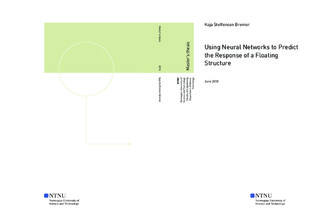| dc.description.abstract | Floating structures are influenced by the ocean environment which cause responses from the structures known as surge, sway, heave, roll, pitch and yaw. These responses are commonly approximated using linear potential theory, which neglects the viscous effects created by interaction between the body and fluid. For conventional ship hulls, Ikeda developed an empirical method to estimate the roll damping [Ikeda, 1978] which is successful for traditional vessel geometries. However, the development of unconventional ship hulls has resulted in the need of better ways to predict the response and viscous effects.
This thesis investigated if Neural Networks could be utilised to predict the response of a floating structure, using experimental results. A two-dimensional model of a mid-ship section with large bilge boxes has been tested in Ladertanken, an experimental wave flume operated by SINTEF Ocean. Due to the large bilge boxes, the model represents an unconventional ship hull shape where the bilge boxes induce viscous effects. The model was freely-floating, although restrained to an area in the model using springs. A wave maker installed in the wave flume created waves with different wave period and wave steepness, which induced motions in sway, heave and roll. The comparison of the created waves versus the theoretical wave showed an average difference between 6.9 % and 7.9 % for both wave steepness and wave period. A bug in the processing software which transforms the analogue signal to a digital signal was found after the experiments were conducted, and there are indications that the results are affected. The results from the experiments could therefore not be used to analyse the development of hydrodynamic effects, however, the results were utilised as data to the response predictions.
Firstly, a Linear Regression model using Stochastic Gradient Descent was created to predict sway, heave and roll motion as well as their response amplitude operators. The Linear Regression models obtained a Coefficient of Determination ranging between 30.0 % and 42.0 %, which is unsatisfactory. The linear regression models were included to compare to the Neural Network performance and thereby show the potential of Neural Network within non-linear problems.
One Neural Network model was built and trained for each of the measured responses, where the responses were used as targets and the wave period and wave steepness were given as features. The input data is scaled using standardisation, as well as shuffled and split into training, testing and validation data sets. The Neural Network consisted of an input layer, two hidden layers and an output layer, where the first hidden layer utilised the Rectified Linear Unit activation function and the second hidden layer utilised tangent hyperbolic. By the use of Mean Squared Error as the loss function and the Root Mean Square Propagation algorithm as optimisation method, the model trained the weights and bias to predict the targets. Using the Coefficient of Determination as the accuracy metric, both motion and response amplitude operator in sway, heave and roll resulted in an accuracy above 98.0 %, where 100.0 % is perfect prediction. From the Mean Absolute Percentage Error, the motions resulted in an accuracy of 5.7 % in sway, 8.5 % in heave and 6.2 % in roll, where 0.0 % is perfect prediction. The response amplitude operator resulted in a Mean Absolute Percentage Error of 2.4 % in sway, 2.7 % in heave and 2.8 % in roll. It was suspected that the use of the wave height in the calculation of the response amplitude operator influences the prediction results, because the wave height was a feature to the Neural Network.
The prediction results showed that it was possible to utilise Neural Network to predict the response of a floating structure. Different indications of prediction error of the two accuracy metrics showed the importance of using more than one error estimate. The predictions were also plotted to visualise the difference between the prediction values and true values, which was important in the evaluation of prediction results. From the prediction plots it was concluded that the Coefficient of Determination was misleading and should not be utilised to assess the Neural Network predictions.
From the knowledge of Neural Networks and Hydrodynamics, a method has been suggested to investigate the development of the viscous terms of the model response using experiments and predictions. With the combination of freely-floating model experiments, forced oscillation model experiments and Neural Networks, a model is trained to predict the viscous terms and thereby contribute with information about the development in various sea states. | |

